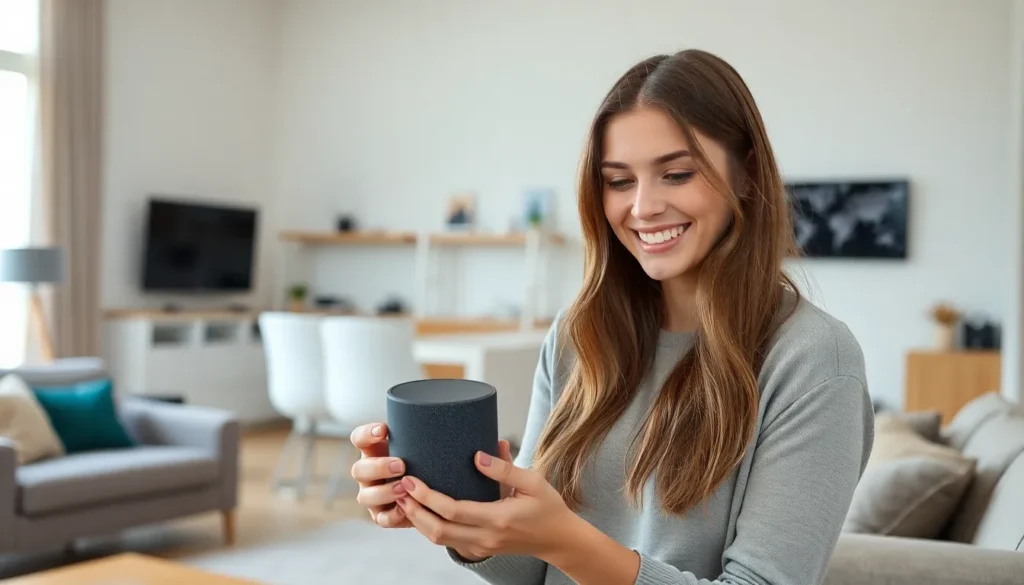Table of Contents
ToggleVoice-activated gadgets have transformed the way people interact with technology, making everyday tasks simpler and more intuitive. With just a few spoken words, users can control their homes, manage schedules, and access information, all while enjoying a hands-free experience. These devices have quickly become essential tools in modern living, catering to a growing demand for convenience and efficiency.
As advancements in artificial intelligence and natural language processing continue to evolve, voice-activated technology is becoming more sophisticated and responsive. From smart speakers to voice-controlled appliances, these gadgets are not only enhancing daily routines but also paving the way for a more connected and automated future. Understanding the benefits and capabilities of these devices can help users make informed decisions and fully embrace the potential of voice-activated technology.
Overview of Voice-Activated Gadgets
Voice-activated gadgets transform daily interactions, enabling users to control devices through spoken commands. These tools include smart speakers, voice assistants, and home automation systems, all designed to improve convenience.
Smart speakers, such as Amazon Echo and Google Nest, serve as central hubs in homes, allowing users to play music, check weather updates, and control smart appliances. Voice assistants like Siri and Alexa utilize advanced artificial intelligence and natural language processing to interpret user requests, facilitating a seamless experience.
Home automation systems integrate voice-activated technology to manage lights, thermostats, and security systems. These devices enhance energy efficiency and provide increased security through remote monitoring and control options.
Overall, the capabilities of voice-activated gadgets continue to evolve, making them essential tools in modern life. They simplify tasks, making technology more accessible and intuitive for a wide range of users.
Benefits of Voice-Activated Gadgets

Voice-activated gadgets enhance everyday tasks through convenience and accessibility, making technology user-friendly for all. Their hands-free operation promotes efficiency, allowing users to multitask and engage with devices effortlessly.
Convenience and Accessibility
Voice-activated gadgets streamline daily tasks, providing easy access to information and services. They support various users, including those with mobility challenges, improving overall accessibility. For instance, smart speakers instantly deliver weather updates, manage schedules, and control smart home devices using voice commands. This hands-free approach reduces reliance on manual controls, creating a more inclusive environment for users with diverse needs.
Hands-Free Operation
Voice-activated gadgets enable seamless interactions through hands-free operation. Users can perform tasks like playing music, setting reminders, or controlling home settings without using their hands. This functionality proves beneficial during cooking, driving, or other activities requiring concentration. Devices like Google Nest and Amazon Echo allow users to interact naturally with technology, enhancing efficiency and encouraging a more integrated lifestyle.
Popular Types of Voice-Activated Gadgets
Voice-activated gadgets encompass various devices designed to enhance user experience through seamless interaction. The most notable categories include smart speakers and voice-controlled home devices.
Smart Speakers
Smart speakers serve as versatile hubs for audio and smart home control. Devices like Amazon Echo and Google Nest allow users to request music, access information, and control other smart devices via voice commands. Equipped with voice assistants like Alexa or Google Assistant, these speakers respond to inquiries in real-time, providing convenience for users. Smart speakers also enable integration with various streaming services and apps, allowing users to manage playlists, adjust volume, and receive personalized news updates effortlessly.
Voice-Controlled Home Devices
Voice-controlled home devices enhance daily living through automation and convenience. Smart devices such as thermostats, lights, and security systems can be monitored and controlled using voice commands. For instance, users can adjust the thermostat temperature or turn on/off lights without physically interacting with their devices. This technology often integrates with smart speakers, enabling a cohesive home automation experience. Voice-controlled home devices increase energy efficiency and provide enhanced security features, such as remote access to surveillance cameras or smart locks.
Challenges and Limitations
Voice-activated gadgets, despite their numerous advantages, face significant challenges and limitations that impact user experience and functionality.
Privacy Concerns
Privacy concerns represent a major drawback for many users. Voice-activated devices often require constant listening to interpret commands, which raises potential security issues. Users worry about unauthorized access to their conversations, as data may be stored and analyzed by companies for service improvement. High-profile privacy breaches and reports of inadvertent recordings further exacerbate these concerns. Users must weigh convenience against the potential risks of personal data exposure.
Compatibility Issues
Compatibility issues hinder the seamless integration of voice-activated gadgets. Not all devices work efficiently with every voice assistant. Differences in technology and protocols can make it challenging for users to establish cohesive smart home ecosystems. For instance, some smart appliances may not support specific voice platforms, leading to frustrating experiences when trying to control devices. As manufacturers rush to create voice-activated products, a lack of standardization persists, complicating users’ ability to create interconnected systems.
Future Trends in Voice-Activated Gadgets
Innovations in voice-activated gadgets promise to redefine user experiences over the next few years. Companies are focusing on increased integration of artificial intelligence (AI) to enhance responsiveness and interaction quality. AI-driven advancements will enable devices to understand context, making communications between users and gadgets more intuitive.
Developments in natural language processing (NLP) continue to refine how devices interpret commands. As NLP algorithms evolve, they improve accuracy in understanding diverse accents and dialects, allowing a broader range of users to engage seamlessly. Enhanced language capabilities will foster inclusivity, increasing accessibility for non-native speakers and individuals with speech disabilities.
Integration with other technologies like augmented reality (AR) is also on the horizon. Voice-activated gadgets may leverage AR environments, enabling users to interact with digital elements in their physical spaces. For instance, users could see visual overlays that provide additional information about their surroundings or receive real-time responses to voice commands projected onto their devices.
Increased focus on privacy features will address ongoing concerns surrounding data security. Manufacturers are likely to implement stronger encryption and user-controlled privacy settings, allowing individuals to regulate how their data is gathered and used. Enhanced transparency about data usage will encourage wider adoption among privacy-conscious consumers.
Enhanced multi-device connectivity will shape the future landscape of voice-activated devices. As the Internet of Things (IoT) expands, users can expect seamless interactions between various smart devices. Gadgets may coordinate actions autonomously through voice commands, allowing for intricate automation scenarios that simplify daily tasks.
Customization options for voice profiles will enrich user experiences. As gadgets become better at recognizing individual voices, personalized settings will cater to preferences for music, information, and device control. Users may enjoy tailored responses and suggestions based on their unique habits and interactions.
Sustainability initiatives will also influence future developments in voice-activated gadgets. Companies may adopt eco-friendly materials and energy-efficient designs, appealing to environmentally conscious consumers. Additionally, smart appliances that promote energy conservation through voice commands will enhance the contribution of these gadgets toward sustainable living.
These trends signal an exciting evolution in voice-activated technologies, promising users more personalized, secure, and efficient interactions in their daily lives.
Voice-activated gadgets are transforming the way people interact with technology. Their ability to simplify tasks and enhance daily living makes them indispensable in modern households. As advancements in AI and natural language processing continue to evolve, these devices are becoming more intuitive and responsive.
While challenges like privacy concerns and compatibility issues remain, the future looks promising. Innovations aimed at improving user experience and security will likely drive the next wave of voice-activated technology. With increasing emphasis on personalization and sustainability, users can expect a more tailored and efficient interaction with their gadgets. Embracing these changes will help individuals make the most of what voice-activated technology has to offer.





